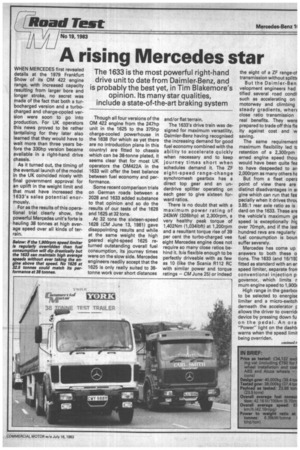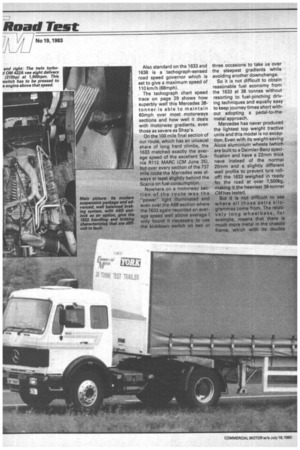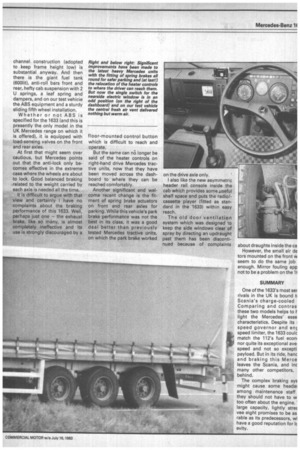A rising Mercedes star
Page 27

Page 28

Page 29

If you've noticed an error in this article please click here to report it so we can fix it.
The 1633 is the most powerful right-hand drive unit to date from Daimler-Benz, and is probably the best yet, in Tim Blakemore's opinion. Its many star qualities, include a state-of-the-art braking system
WHEN MERCEDES first revealed details at the 1979 Frankfurt Show of its OM 422 engine range, with increased capacity resulting from larger bore and longer stroke, no secret was made of the fact that both a turbocharged version and a turbocharged and charge-cooled version were soon to go into production. For UK operators this news proved to be rather tantalising for they later also learned that they would have to wait more than three years before the 330hp version became available in a right-hand drive chassis.
As it turned out, the timing of the eventual launch of the model in the UK coincided nicely with final government approval for an uplift in the weight limit and that must have increased the 1633's sales potential enormously.
For as the results of this operational trial clearly show, the powerful Mercedes unit's forte is hauling 38 tonnes at high average speed over all kinds of terrain. Though all four versions of the OM 422 engine from the 247hp unit in the 1625 to the 375hp charge-cooled powerhouse in the 1638 (for which as yet there are no introduction plans in this country) are fitted to chassis which can be 38-tonne plated, it seems clear that for most UK operators the 0M422A in the 1633 will offer the best balance between fuel economy and performance.
Some recent comparison trials on German roads between a 2028 and 1633 added substance to that opinion and so do the results of our tests of the 1628 and 1625 at 32 tons.
At 32 tons the sixteen-speed 1628 (CM June 13, 1981) gave disappointing results and while at the same weight the high geared eight-speed 1625 returned outstanding overall fuel consumption, its journey times were on the slow side. Mercedes engineers readily accept that the 1625 is only really suited to 38tonne work over short distances and/or flat terrain.
The 1633's drive train was designed for maximum versatility, Daimler-Benz having recognised the increasing demand for good fuel economy combined with the ability to accelerate quickly when necessary and to keep journey times short when schedules demand it. The ZF eight-speed range-change synchromesh gearbox has a direct top gear and an underdrive splitter operating on each gear to give sixteen forward ratios.
There is no doubt that with a maximum power rating of 243kW (326bhp) at 2,300rpm, a very healthy peak torque of 1,402Nm (1,034Ibft) at 1,200rpm and a resultant torque rise of 39 per cent the turbo-charged vee eight Mercedes engine does not require so many close ratios behind it. It is flexible enough to be perfectly driveable with as few as 10 (like the Scania R112 RC with similar power and torque ratings — CM June 25) or indeed the eight of a ZF range-ct transmission without splittE But the Daimler-Ben. velopment engineers had tified several road condi' such as accelerating on motorway and climbing steady gradients, wherE close ratio transmission real benefits. They were prepared to trade off this fie ity against cost and w saving.
The same requirement maximum flexibility led tc retention of a 2,300rpm erned engine speed thou! would have been quite fea to have despeeded to an 2,000 rpm as many others hE But from a fleet opere point of view there are distinct disadvantages in al gine which can run that fas pecially when it drives th rot 3.85:1 rear axle ratio as is dard on the 1633. These are the vehicle's maximum ge speed is exceptionally hig over 70mph, and if the Iasi hundred revs are regularly fuel consumption is boun suffer severely.
Mercedes has come up answers to both these o tions. The 1633 (and 16/19:: fitted as standard with an er speed limiter, separate hot" conventional injection p governor, which limits r mum engine speed to 1,9001 High range in the gearbo) to be selected to energise limiter and a micro-switch derneath the accelerator allows the driver to overrich device by pressing down fu on the pedal. An ora "Power" light on the dashb warns when the speed limit being overriden. Also standard on the 1633 and 1638 is a tachograph-sensed road speed governor which is set to give a maximum speed of 110 km/h (68mph).
The tachograph chart speed trace on page 29 shows how superbly welt this Mercedes 38tonner is able to maintain 60mph over most motorways sections and how well it deals with motorway gradients, even those as severe as Shap's.
On the 100 mile final section of our route, which has an unusual share of long hard climbs, the 1633 matched exactly the average speed of the excellent Scania R112 MARC (CM June 25), but over every section of the 737 mile route the Mercedes was always at least slightly behind the Scania on fuel consumption.
Nowhere on a motorway section of the route was the "power light illuminated and even over the A68 section where the 1633 again recorded an average speed well above average I only found it necessary to use the kickdown switch on two or three occasions to take us over the steepest gradients while avoiding another downchange.
So it is not difficult to obtain reasonable fuel economy from the 1633 at 38 tonnes without resorting to fuel-pinching driving techniques and equally easy to keep journey times short without adopting a pedal-to-themetal approach.
Mercedes has never produced the lightest top weight tractive units and this model is no exception. Even with its weight-saving Alcoa aluminium wheels (which are built to a Daimler-Benz specification and have a 22mm thick nave instead of the normal 20mm and a slightly different well profile to prevent tyre rolloff) the 1633 weighed in ready for the road at over 7,500kg, making it the heaviest 38-tonner CM has tested.
But it is not difficult to see where all those extra kilo grammes come from. The relat vely long wheelbase, fo example, means that there t much more metal in the chess frame, which with its doubt channel construction (adopted to keep frame height low) is substantial anyway. And then there is the giant fuel tank (6001it), anti-roll bars front and rear, hefty cab suspension with 2 U springs, a leaf spring and dampers, and on our test vehicle the ABS equipment and a sturdy sliding fifth wheel installation.
Whether or not ABS is specified for the 1633 (and this is presently the only model in the UK Mercedes range on which it is offered), it is equipped with load-sensing valves on the front and rear axles.
At first that might seem over cautious, but Mercedes points out that the anti-lock only becomes effective in the extreme case where the wheels are about to lock. Good balanced braking ,related to the weight carried by each axle is needed all the time.
It is difficult to argue with that view and certainly I have no complaints about the braking performance of this 1633. Well, perhaps just one — the exhaust brake, like so many, is almost completely ineffective and its use is strongly discouraged by a
floor-mounted control button which is difficult to reach and operate.
But the same can nO longer be said of the heater controls on right-hand drive Mercedes tractive units, now that they have been moved across the dashboard to where they can be reached comfortably.
Another significant and welcome recent change is the fitment of spring brake actuators on front and rear axles for parking. While this vehicle's park brake performance was not the best in its class, it was a good deal better than previously tested Mercedes tractive units, on which the park brake worked on the drive axle only.
I also like the new asymmetric header rail console inside the cab which provides some .useful shelf space and puts the radio!cassette player (fitted as standard in the 1633) within easy reach.
The old door ventilation system which was designed to keep the side windows clear of spray by directing an updraught past them has been discontinued because of complaints about draughts inside the ca However, the small air de tors mounted on the front w seem to do the same job enough. Mirror fouling app not to be a problem on the 11 SUMMARY
One of the 1633's most ser rivals in the UK is bound ti Scania's charge-cooled Comparing and contras these two models helps to light the Mercedes' esse characteristics. Despite its speed governor and enc. speed limiter, the 1633 coulc match the 112's fuel econi nor quite its exceptional ave speed and not so excepti payload. But in its ride, hanc and braking this Merce leaves the Scania, and inc many other competitors, behind.
The complex braking sys might cause some heada( among maintenance staff they should not have to w too often about the engine.. large capacity, lightly stres vee eight promises to be as rable as its predecessors, wl have a good reputation for lc evity.
























































































